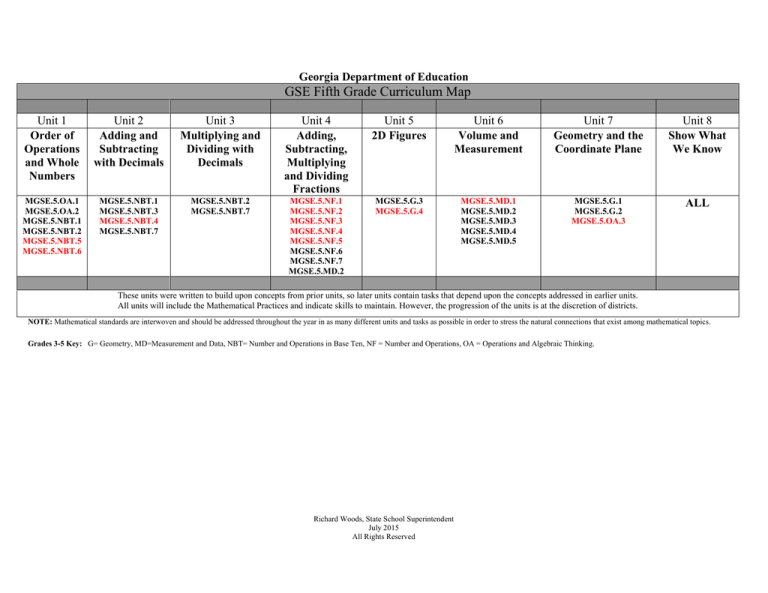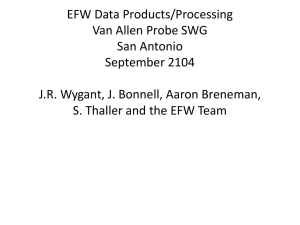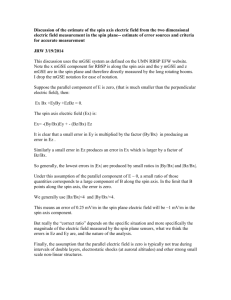
Georgia Department of Education
GSE Fifth Grade Curriculum Map
Unit 1
Order of
Operations
and Whole
Numbers
Unit 2
Adding and
Subtracting
with Decimals
Unit 3
Multiplying and
Dividing with
Decimals
Unit 4
Adding,
Subtracting,
Multiplying
and Dividing
Fractions
Unit 5
2D Figures
Unit 6
Volume and
Measurement
Unit 7
Geometry and the
Coordinate Plane
Unit 8
Show What
We Know
MGSE.5.OA.1
MGSE.5.OA.2
MGSE.5.NBT.1
MGSE.5.NBT.2
MGSE.5.NBT.5
MGSE.5.NBT.6
MGSE.5.NBT.1
MGSE.5.NBT.3
MGSE.5.NBT.4
MGSE.5.NBT.7
MGSE.5.NBT.2
MGSE.5.NBT.7
MGSE.5.NF.1
MGSE.5.NF.2
MGSE.5.NF.3
MGSE.5.NF.4
MGSE.5.NF.5
MGSE.5.NF.6
MGSE.5.NF.7
MGSE.5.MD.2
MGSE.5.G.3
MGSE.5.G.4
MGSE.5.MD.1
MGSE.5.MD.2
MGSE.5.MD.3
MGSE.5.MD.4
MGSE.5.MD.5
MGSE.5.G.1
MGSE.5.G.2
MGSE.5.OA.3
ALL
These units were written to build upon concepts from prior units, so later units contain tasks that depend upon the concepts addressed in earlier units.
All units will include the Mathematical Practices and indicate skills to maintain. However, the progression of the units is at the discretion of districts.
NOTE: Mathematical standards are interwoven and should be addressed throughout the year in as many different units and tasks as possible in order to stress the natural connections that exist among mathematical topics.
Grades 3-5 Key: G= Geometry, MD=Measurement and Data, NBT= Number and Operations in Base Ten, NF = Number and Operations, OA = Operations and Algebraic Thinking.
Richard Woods, State School Superintendent
July 2015
All Rights Reserved
Georgia Department of Education
GSE Fifth Grade
GSE Fifth Grade Expanded Curriculum Map
Standards for Mathematical Practice
5 Use appropriate tools strategically.
6 Attend to precision.
7 Look for and make use of structure.
8 Look for and express regularity in repeated reasoning.
1 Make sense of problems and persevere in solving them.
2 Reason abstractly and quantitatively.
3 Construct viable arguments and critique the reasoning of others.
4 Model with mathematics.
Unit 1
Unit 2
Unit 3
Unit 4
Order of Operations and Whole
Numbers
Adding and Subtracting with
Decimals
Multiplying and Dividing with
Decimals
Adding, Subtracting, Multiplying,
and Dividing Fractions
Write and interpret numerical expressions.
MGSE.5.OA.1 Use parentheses, brackets, or
braces in numerical expressions, and evaluate
expressions with these symbols.
MGSE.5.OA.2 Write simple expressions that
record calculations with numbers, and
interpret numerical expressions without
evaluating them. For example, express the
calculation “add 8 and 7, then multiply by 2”
as 2 × (8 + 7). Recognize that 3 × (18932 +
921) is three times as large as 18932 + 921,
without having to calculate the indicated sum
or product.
Understand the place value system.
MGSE.5.NBT.1 Recognize that in a multidigit number, a digit in one place represents
10 times as much as it represents in the place
to its right and 1/10 of what it represents in the
place to its left.
MGSE.5.NBT.2 Explain patterns in the
number of zeros of the product when
multiplying a number by powers of 10, and
explain patterns in the placement of the
decimal point when a decimal is multiplied or
divided by a power of 10. Use whole-number
exponents to denote powers of 10.
Understand the place value system.
MGSE.5.NBT.1 Recognize that in a multidigit number, a digit in one place represents
10 times as much as it represents in the place
to its right and 1/10 of what it represents in the
place to its left.
MGSE.5.NBT.3 Read, write, and compare
decimals to thousandths.
a. Read and write decimals to
thousandths using base-ten
numerals, number names, and
expanded form, e.g., 347.392 = 3 ×
100 + 4 × 10 + 7 × 1 + 3 × (1/10) +
9 × (1/100) + 2 × (1/1000).
b. Compare two decimals to
thousandths based on meanings of
the digits in each place, using >, =,
and < symbols to record the results
of comparisons.
MGSE.5.NBT.4 Use place value
understanding to round decimals up to the
hundredths place.
Perform operations with multi-digit whole
numbers and with decimals to hundredths.
MGSE.5.NBT.7 Add, subtract, multiply, and
divide decimals to hundredths, using concrete
models or drawings and strategies based on
place value, properties of operations, and/or
Understand the place value system.
MGSE.5.NBT.2 Explain patterns in the
number of zeros of the product when
multiplying a number by powers of 10, and
explain patterns in the placement of the
decimal point when a decimal is multiplied or
divided by a power of 10. Use whole-number
exponents to denote powers of 10.
Perform operations with multi-digit whole
numbers and with decimals to hundredths.
MGSE.5.NBT.7 Add, subtract, multiply, and
divide decimals to hundredths, using concrete
models or drawings and strategies based on
place value, properties of operations, and/or
the relationship between addition and
subtraction; relate the strategy to a written
method and explain the reasoning used.
Use equivalent fractions as a strategy to
add and subtract fractions.
MGSE.5.NF.1 Add and subtract fractions
and mixed numbers with unlike
denominators by finding a common
denominator and equivalent fractions to
produce like denominators.
MGSE.5.NF.2 Solve word problems
involving addition and subtraction of
fractions, including cases of unlike
denominators (e.g., by using visual fraction
models or equations to represent the
problem). Use benchmark fractions and
number sense of fractions to estimate
mentally and assess the reasonableness of
answers. For example, recognize an
incorrect result 2/5 + ½ = 3/7, by observing
that 3/7 < ½.
Apply and extend previous understandings
of multiplication and division to multiply
and divide fractions.
MGSE.5.NF.3 Interpret a fraction as
division of the numerator by the
denominator (a/b = a ÷ b). Solve word
problems involving division of whole
numbers leading to answers in the form of
fractions or mixed numbers, e.g., by using
visual fraction models or equations to
Richard Woods, State School Superintendent
July 2015
All Rights Reserved
Georgia Department of Education
Perform operations with multi-digit whole
numbers and with decimals to hundredths.
MGSE.5.NBT.5 Fluently multiply multidigit whole numbers using the standard
algorithm (or other strategies
demonstrating understanding of
multiplication) up to a 3 digit by 2 digit
factor.
MGSE.5.NBT.6. Fluently divide up to 4digit dividends and 2-digit divisors by using
at least one of the following methods:
strategies based on place value, the
properties of operations, and/or the
relationship between multiplication and
division. Illustrate and explain the
calculation by using equations or concrete
models. (e.g., rectangular arrays, area
models)
the relationship between addition and
subtraction; relate the strategy to a written
method and explain the reasoning used.
3
represent the problem. Example: 5 can be
interpreted as “3 divided by 5 and as 3
shared by 5”.
MGSE.5.NF.4 Apply and extend previous
understandings of multiplication to multiply a
fraction or whole number by a fraction.
a. Apply and use understanding of
multiplication to multiply a
fraction or whole number by a
fraction.
𝑎
𝑎
𝑞
Examples 𝑏 × 𝑞 as𝑏 × 1 and
b.
𝑎
𝑐
𝑎𝑎
× 𝑑 = 𝑏𝑏
Find the area of a rectangle with
fractional side lengths by tiling it
with unit squares of the
appropriate unit fraction side
lengths, and show that the area is
the same as would be found by
multiplying the side lengths.
𝑏
MGSE.5.NF.5 Interpret multiplication as
scaling (resizing), by:
a.
Comparing the size of a product to
the size of one factor on the basis
of the size of the other factor,
without performing the indicated
multiplication. Example 4 x 10 is
twice as large as 2 x 10.
b.
Explaining why multiplying a
given number by a fraction greater
than 1 results in a product greater
than the given number
(recognizing multiplication by
whole numbers greater than 1 as a
familiar case); explaining why
multiplying a given number by a
fraction less than 1 results in a
product smaller than the given
number; and relating the principle
of fraction equivalence a/b =
(n×a)/(n×b) to the effect of
multiplying a/b by 1.
Richard Woods, State School Superintendent
July 2015
All Rights Reserved
Georgia Department of Education
MGSE.5.NF.6 Solve real world problems
involving multiplication of fractions and
mixed numbers, e.g., by using visual fraction
models or equations to represent the problem.
MGSE.5.NF.7 Apply and extend previous
understandings of division to divide unit
fractions by whole numbers and whole
numbers by unit fractions. 1
a. Interpret division of a unit
fraction by a non-zero whole
number, and compute such
quotients. For example, create
a story context for (1/3) ÷ 4,
and use a visual fraction model
to show the quotient. Use the
relationship between
multiplication and division to
explain that (1/3) ÷ 4 = 1/12
because (1/12) × 4 = 1/3.
b. Interpret division of a whole
number by a unit fraction, and
compute such quotients. For
example, create a story context
for 4 ÷ (1/5), and use a visual
fraction model to show the
quotient. Use the relationship
between multiplication and
division to explain that 4 ÷
(1/5) = 20 because 20 × (1/5) =
4.
c. Solve real world problems
involving division of unit
fractions by non-zero whole
numbers and division of whole
numbers by unit fractions, e.g.,
by using visual fraction models
and equations to represent the
1
Students able to multiply fractions in general can develop strategies to divide fractions in general, by reasoning about the relationship between multiplication and division. But division of a fraction by a
fraction is not a requirement at this grade.
Richard Woods, State School Superintendent
July 2015
All Rights Reserved
Georgia Department of Education
problem. For example, how
much chocolate will each
person get if 3 people share 1/2
lb of chocolate equally? How
many 1/3-cup servings are in 2
cups of raisins?
Represent and interpret data.
MGSE.5.MD.2 Make a line plot to display a
data set of measurements in fractions of a unit
(1/2, 1/4, 1/8). Use operations on fractions for
this grade to solve problems involving
information presented in line plots. For
example, given different measurements of
liquid in identical beakers, find the amount of
liquid each beaker would contain if the total
amount in all the beakers were redistributed
equally.
Richard Woods, State School Superintendent
July 2015
All Rights Reserved
Georgia Department of Education
GSE Fifth Grade
GSE Fifth Grade Expanded Curriculum Map
1 Make sense of problems and persevere in solving them.
2 Reason abstractly and quantitatively.
3 Construct viable arguments and critique the reasoning of others.
4 Model with mathematics.
Standards for Mathematical Practice
5 Use appropriate tools strategically.
6 Attend to precision.
7 Look for and make use of structure.
8 Look for and express regularity in repeated reasoning.
Unit 5
Unit 6
Unit 7
Unit 8
2D Figures
Volume and Measurement
Geometry and the Coordinate Plane
Show What We Know
Classify two-dimensional figures into
categories based on their properties.
MGSE.5.G.3 Understand that attributes
belonging to a category of two-dimensional
figures also belong to all subcategories of
that category. For example, all rectangles
have four right angles and squares are
rectangles, so all squares have four right
angles.
MGSE.5.G.4. Classify two-dimensional
figures in a hierarchy based on properties
(polygons, triangles, and quadrilaterals).
Convert like measurement units within a
given measurement system.
MCC5.MD.1 Convert among differentsized standard measurement units (mass,
weight, length, time, etc.) within a given
measurement system (customary and metric)
(e.g., convert 5cm to 0.05m), and use these
conversions in solving multi-step, real world
problems.
Represent and interpret data.
MCC5.MD.2 Make a line plot to display a
data set of measurements in fractions of a unit
(1/2, 1/4, 1/8). Use operations on fractions for
this grade to solve problems involving
information presented in line plots. For
example, given different measurements of liquid
in identical beakers, find the amount of liquid
each beaker would contain if the total amount
in all the beakers were redistributed equally.
Geometric Measurement: understand
concepts of volume and relate volume to
multiplication and division.
MCC5.MD.3 Recognize volume as an
attribute of solid figures and understand
concepts of volume measurement.
a. A cube with side length 1 unit, called
a “unit cube,” is said to have “one
cubic unit” of volume, and can be
used to measure volume.
Graph points on the coordinate plane to solve realworld and mathematical problems.
MGSE.5.G.1 Use a pair of perpendicular number
lines, called axes, to define a coordinate system, with
the intersection of the lines (the origin) arranged to
coincide with the 0 on each line and a given point in
the plane located by using an ordered pair of numbers,
called its coordinates. Understand that the first number
indicates how far to travel from the origin in the
direction of one axis, and the second number indicates
how far to travel in the direction of the second axis,
with the convention that the names of the two axes and
the coordinates correspond (e.g., x-axis and xcoordinate, y-axis and y-coordinate).
MGSE.5.G.2 Represent real world and mathematical
problems by graphing points in the first quadrant of the
coordinate plane, and interpret coordinate values of
points in the context of the situation.
Analyze patterns and relationships.
MGSE.5.OA.3 Generate two numerical patterns
using a given rule. Identify apparent relationships
between corresponding terms by completing a
function table or input/output table. Using the
terms created, form and graph ordered pairs on a
coordinate plane.
ALL
Richard Woods, State School Superintendent
July 2015
All Rights Reserved
Georgia Department of Education
b.
A solid figure which can be packed
without gaps or overlaps using n unit
cubes is said to have a volume of n
cubic units.
MCC5.MD.4 . Measure volumes by counting
unit cubes, using cubic cm, cubic in, cubic ft,
and improvised units.
MCC5.MD.5 Relate volume to the operations
of multiplication and addition and solve real
world and mathematical problems involving
volume.
a. Find the volume of a right rectangular
prism with whole-number side
lengths by packing it with unit cubes,
and show that the volume is the same
as would be found by multiplying the
edge lengths, equivalently by
multiplying the height by the area of
the base. Represent threefold wholenumber products as volumes, e.g., to
represent the associative property of
multiplication.
b. Apply the formulas V = l × w × h and
V = b × h for rectangular prisms to
find volumes of right rectangular
prisms with whole number edge
lengths in the context of solving real
world and mathematical problems.
c. Recognize volume as additive. Find
volumes of solid figures composed of
two non-overlapping right
rectangular prisms by adding the
volumes of the non-overlapping
parts, applying this technique to solve
real world problems.
Richard Woods, State School Superintendent
July 2015
All Rights Reserved



